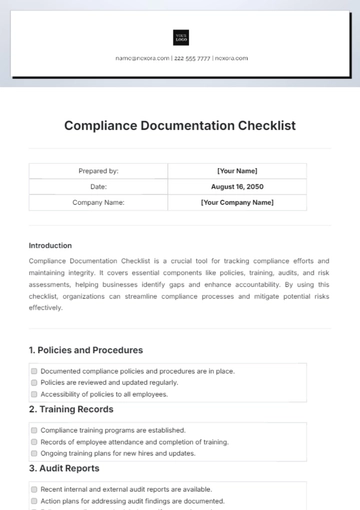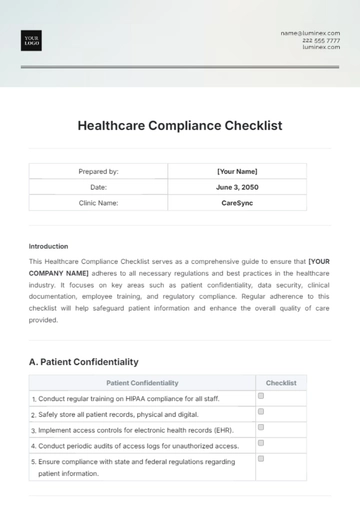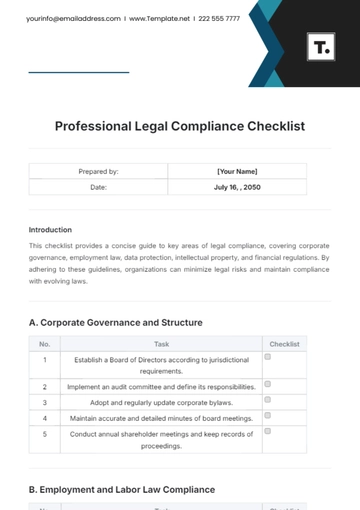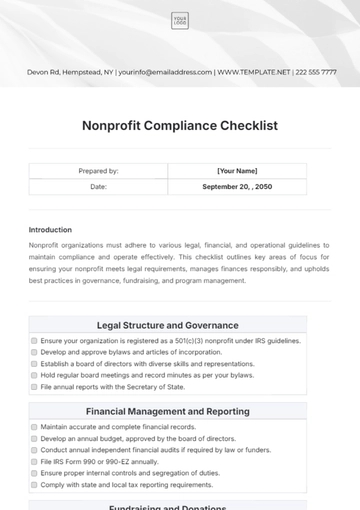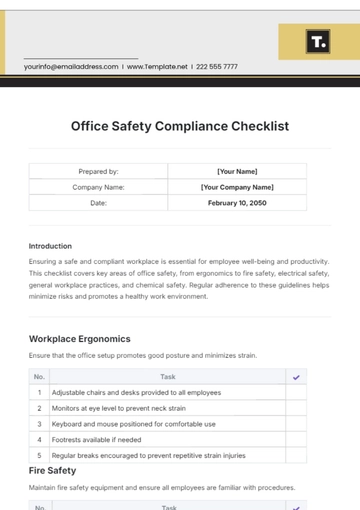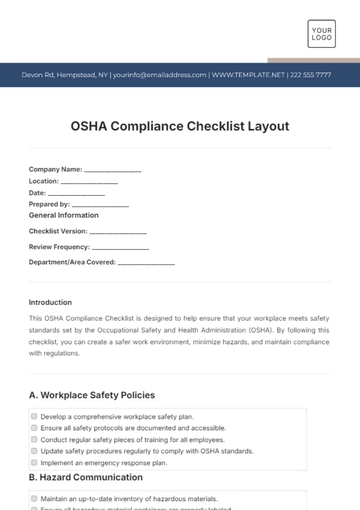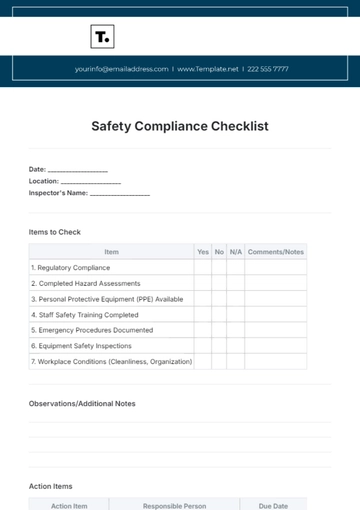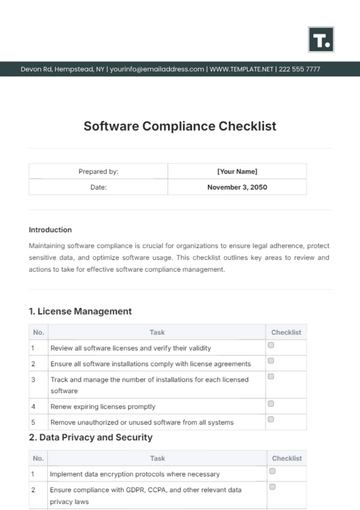Free Nursing Home OSHA Compliance Checklist for Nursing Homes
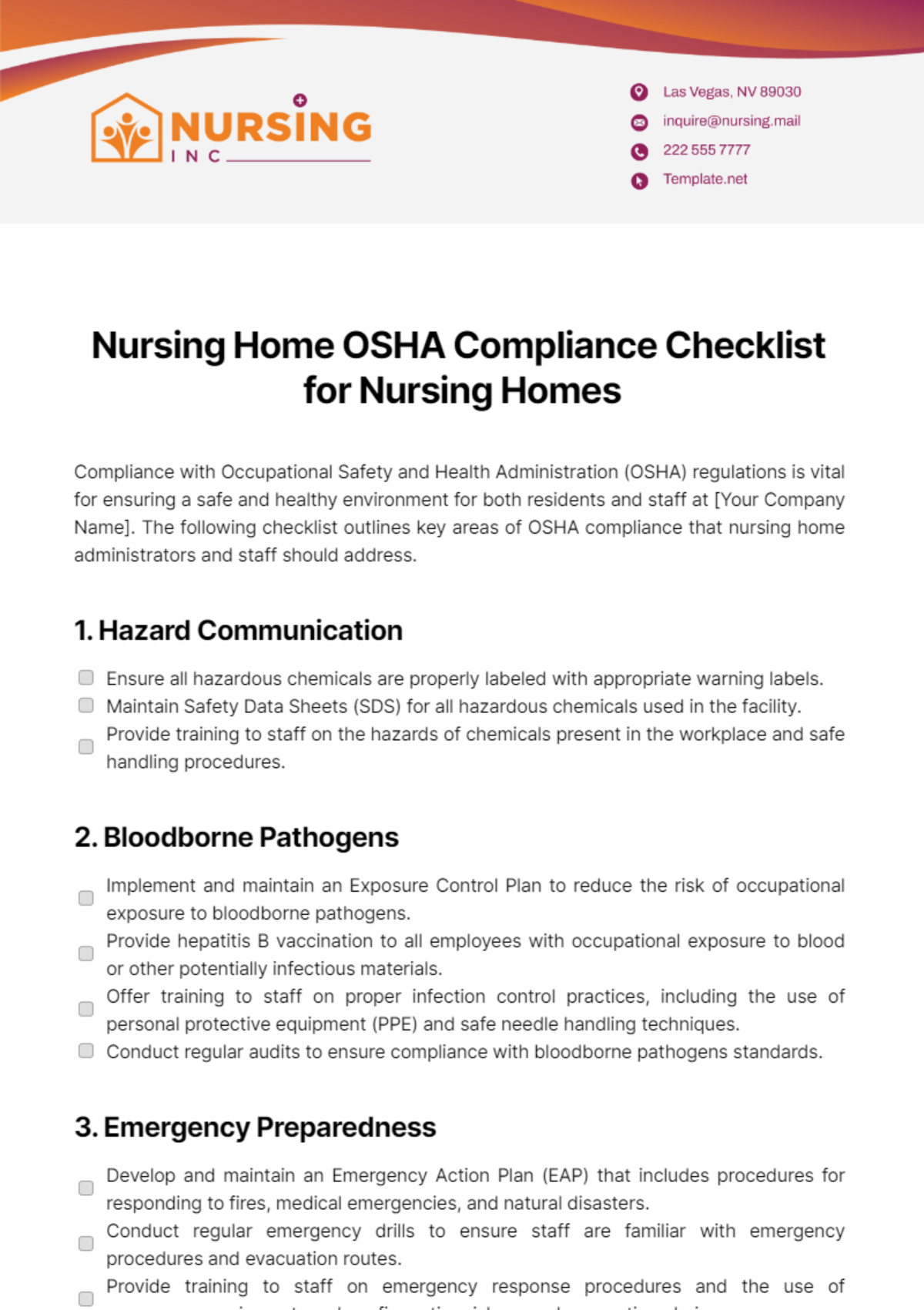
Compliance with Occupational Safety and Health Administration (OSHA) regulations is vital for ensuring a safe and healthy environment for both residents and staff at [Your Company Name]. The following checklist outlines key areas of OSHA compliance that nursing home administrators and staff should address.
1. Hazard Communication
Ensure all hazardous chemicals are properly labeled with appropriate warning labels.
Maintain Safety Data Sheets (SDS) for all hazardous chemicals used in the facility.
Provide training to staff on the hazards of chemicals present in the workplace and safe handling procedures.
2. Bloodborne Pathogens
Implement and maintain an Exposure Control Plan to reduce the risk of occupational exposure to bloodborne pathogens.
Provide hepatitis B vaccination to all employees with occupational exposure to blood or other potentially infectious materials.
Offer training to staff on proper infection control practices, including the use of personal protective equipment (PPE) and safe needle handling techniques.
Conduct regular audits to ensure compliance with bloodborne pathogens standards.
3. Emergency Preparedness
Develop and maintain an Emergency Action Plan (EAP) that includes procedures for responding to fires, medical emergencies, and natural disasters.
Conduct regular emergency drills to ensure staff are familiar with emergency procedures and evacuation routes.
Provide training to staff on emergency response procedures and the use of emergency equipment, such as fire extinguishers and evacuation chairs.
4. Slips, Trips, and Falls
Implement measures to prevent slips, trips, and falls, such as keeping floors clean and dry and promptly addressing spills.
Ensure adequate lighting in all areas of the facility to reduce the risk of accidents.
Provide training to staff on proper lifting techniques and the use of assistive devices to prevent musculoskeletal injuries.
Conduct regular inspections of walking surfaces and stairways to identify and address potential hazards.
5. Personal Protective Equipment (PPE)
Assess workplace hazards to determine the appropriate PPE required for each job task.
Provide employees with the necessary PPE, such as gloves, goggles, and respirators, free of charge.
Train staff on the proper use, maintenance, and disposal of PPE.
Conduct regular fit testing for respirators to ensure proper fit and protection.
6. Electrical Safety
Inspect electrical equipment regularly to identify and address potential hazards, such as frayed cords or exposed wires.
Ensure all electrical outlets are properly grounded and circuits are not overloaded.
Provide training to staff on electrical safety practices, including how to recognize and report electrical hazards.
7. Fire Safety
Maintain working smoke detectors and fire alarm systems throughout the facility.
Conduct regular inspections and testing of fire extinguishers and emergency lighting systems.
Develop and implement a Fire Prevention Plan that includes procedures for evacuating residents and staff in the event of a fire.
Provide training to staff on fire prevention techniques, evacuation procedures, and the use of fire extinguishers.
8. Workplace Violence Prevention
Develop and implement a Workplace Violence Prevention Program that includes procedures for identifying and addressing potential risks.
Provide training to staff on recognizing and de-escalating potentially violent situations.
Establish a system for reporting and investigating incidents of workplace violence and implementing corrective actions as needed.
Conduct regular assessments of workplace violence risks and update prevention strategies as necessary.
9. Respiratory Protection
Assess the need for respiratory protection based on potential exposure to airborne hazards, such as infectious diseases or hazardous chemicals.
Provide employees with appropriate respiratory protection, such as N95 respirators, and ensure they are properly fitted.
Train staff on the proper use, maintenance, and storage of respiratory protective equipment.
10. Lifting and Ergonomics
Implement ergonomic solutions to reduce the risk of musculoskeletal injuries associated with lifting and moving residents.
Provide training to staff on proper lifting techniques and the use of mechanical lifting aids.
Encourage staff to report ergonomic concerns and implement corrective actions to address them.
11. Infection Control
Develop and implement an Infection Control Program that includes procedures for preventing the spread of infectious diseases.
Provide training to staff on infection control practices, including hand hygiene, proper use of personal protective equipment, and environmental cleaning.
12. Recordkeeping and Documentation
Maintain records of workplace injuries and illnesses as required by OSHA regulations.
Document training sessions, inspections, and corrective actions taken to address identified hazards.
Keep records of medical surveillance activities, such as employee vaccinations and TB screenings, as required by OSHA standards.
- 100% Customizable, free editor
- Access 1 Million+ Templates, photo’s & graphics
- Download or share as a template
- Click and replace photos, graphics, text, backgrounds
- Resize, crop, AI write & more
- Access advanced editor
Ensure compliance with OSHA regulations with Template.net's Nursing Home OSHA Compliance Checklist Template. Editable in our AI Editor Tool, this customizable template provides a structured format for assessing compliance with Occupational Safety and Health Administration (OSHA) regulations, including workplace safety, hazard communication, infection control, and emergency preparedness. Enhance safety protocols with this user-friendly template!
You may also like
- Cleaning Checklist
- Daily Checklist
- Travel Checklist
- Self Care Checklist
- Risk Assessment Checklist
- Onboarding Checklist
- Quality Checklist
- Compliance Checklist
- Audit Checklist
- Registry Checklist
- HR Checklist
- Restaurant Checklist
- Checklist Layout
- Creative Checklist
- Sales Checklist
- Construction Checklist
- Task Checklist
- Professional Checklist
- Hotel Checklist
- Employee Checklist
- Moving Checklist
- Marketing Checklist
- Accounting Checklist
- Camping Checklist
- Packing Checklist
- Real Estate Checklist
- Cleaning Checklist Service
- New Employee Checklist
- Food Checklist
- Home Inspection Checklist
- Advertising Checklist
- Event Checklist
- SEO Checklist
- Assessment Checklist
- Inspection Checklist
- Baby Registry Checklist
- Induction Checklist
- Employee Training Checklist
- Medical Checklist
- Safety Checklist
- Site Checklist
- Job Checklist
- Service Checklist
- Nanny Checklist
- Building Checklist
- Work Checklist
- Office Checklist
- Training Checklist
- Website Checklist
- IT and Software Checklist
- Performance Checklist
- Project Checklist
- Startup Checklist
- Education Checklist
- Home Checklist
- School Checklist
- Maintenance Checklist
- Planning Checklist
- Manager Checklist
- Wedding Checklist
- Vehicle Checklist
- Travel Agency Checklist
- Vehicle Inspection Checklist
- Interior Design Checklist
- Backpacking Checklist
- Business Checklist
- Legal Checklist
- Nursing Home Checklist
- Weekly Checklist
- Recruitment Checklist
- Salon Checklist
- Baby Checklist
- Equipment Checklist
- Trade Show Checklist
- Party Checklist
- Hospital Bag Checklist
- Evaluation Checklist
- Agency Checklist
- First Apartment Checklist
- Hiring Checklist
- Opening Checklist
- Small Business Checklist
- Rental Checklist
- College Dorm Checklist
- New Puppy Checklist
- University Checklist
- Building Maintenance Checklist
- Work From Home Checklist
- Student Checklist
- Application Checklist



